Measuring Green Building Progress: EmiratesGBC's Initiatives & Impact
VerifiedAdded on 2023/06/11
|33
|10203
|61
Report
AI Summary
This report examines the Emirates Green Building Council's (EmiratesGBC) role in advancing green building practices and reducing the ecological footprint of the United Arab Emirates (UAE). It analyzes the UAE's environmental impact, referencing the Living Planet Report (LPR) and data from the Global Footprint Network (GFN). The report details the evolution of the UAE's built environment, governmental initiatives such as the Royal 'Green' Decree, Dubai Supreme Council of Energy (DSCE), and Estidama, and the EmiratesGBC's formation, mission, and various programs including energy efficiency programs, events, training, and partnerships. It also addresses challenges faced by EmiratesGBC, such as the economic crisis and market uptake, and concludes by highlighting the organization's contribution to promoting sustainable building practices in the UAE.
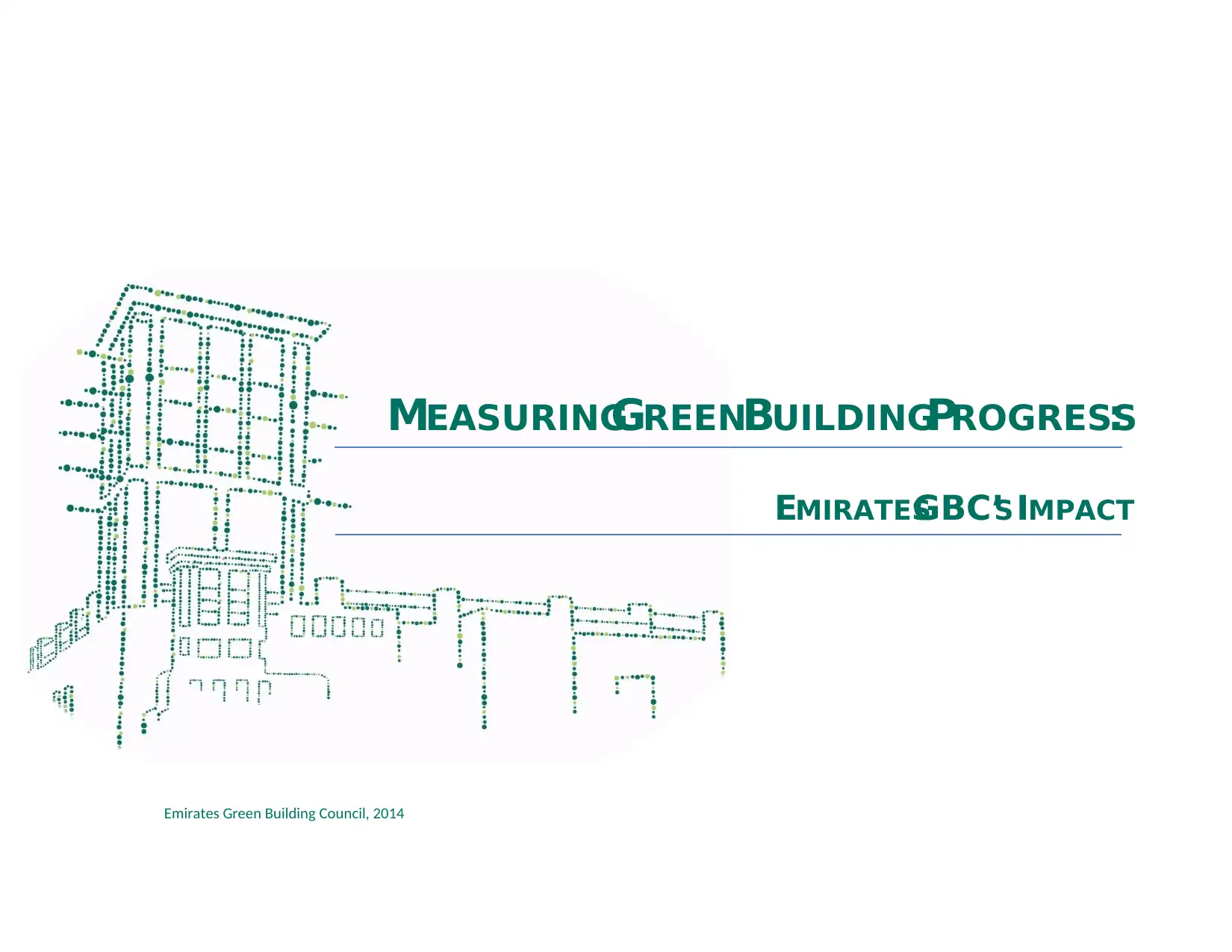
MEASURINGGREENBUILDINGPROGRESS:
EMIRATESGBC’S IMPACT
Emirates Green Building Council, 2014
EMIRATESGBC’S IMPACT
Emirates Green Building Council, 2014
Paraphrase This Document
Need a fresh take? Get an instant paraphrase of this document with our AI Paraphraser
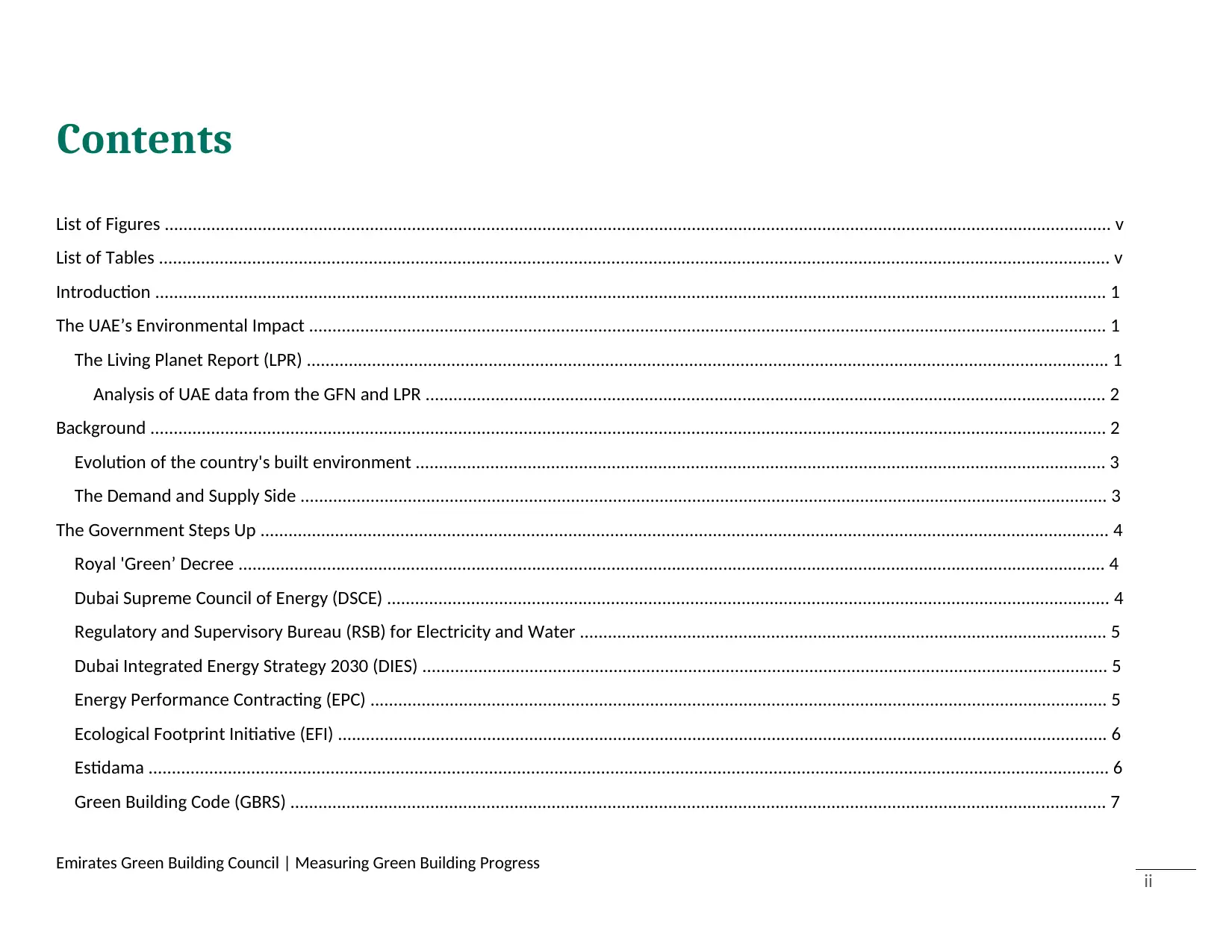
Emirates Green Building Council | Measuring Green Building Progress
ii
Contents
List of Figures ........................................................................................................................................................................................................... v
List of Tables ............................................................................................................................................................................................................ v
Introduction ............................................................................................................................................................................................................ 1
The UAE’s Environmental Impact ........................................................................................................................................................................... 1
The Living Planet Report (LPR) ............................................................................................................................................................................ 1
Analysis of UAE data from the GFN and LPR .................................................................................................................................................. 2
Background ............................................................................................................................................................................................................. 2
Evolution of the country's built environment .................................................................................................................................................... 3
The Demand and Supply Side ............................................................................................................................................................................. 3
The Government Steps Up ...................................................................................................................................................................................... 4
Royal 'Green’ Decree .......................................................................................................................................................................................... 4
Dubai Supreme Council of Energy (DSCE) ........................................................................................................................................................... 4
Regulatory and Supervisory Bureau (RSB) for Electricity and Water ................................................................................................................. 5
Dubai Integrated Energy Strategy 2030 (DIES) ................................................................................................................................................... 5
Energy Performance Contracting (EPC) .............................................................................................................................................................. 5
Ecological Footprint Initiative (EFI) ..................................................................................................................................................................... 6
Estidama .............................................................................................................................................................................................................. 6
Green Building Code (GBRS) ............................................................................................................................................................................... 7
ii
Contents
List of Figures ........................................................................................................................................................................................................... v
List of Tables ............................................................................................................................................................................................................ v
Introduction ............................................................................................................................................................................................................ 1
The UAE’s Environmental Impact ........................................................................................................................................................................... 1
The Living Planet Report (LPR) ............................................................................................................................................................................ 1
Analysis of UAE data from the GFN and LPR .................................................................................................................................................. 2
Background ............................................................................................................................................................................................................. 2
Evolution of the country's built environment .................................................................................................................................................... 3
The Demand and Supply Side ............................................................................................................................................................................. 3
The Government Steps Up ...................................................................................................................................................................................... 4
Royal 'Green’ Decree .......................................................................................................................................................................................... 4
Dubai Supreme Council of Energy (DSCE) ........................................................................................................................................................... 4
Regulatory and Supervisory Bureau (RSB) for Electricity and Water ................................................................................................................. 5
Dubai Integrated Energy Strategy 2030 (DIES) ................................................................................................................................................... 5
Energy Performance Contracting (EPC) .............................................................................................................................................................. 5
Ecological Footprint Initiative (EFI) ..................................................................................................................................................................... 6
Estidama .............................................................................................................................................................................................................. 6
Green Building Code (GBRS) ............................................................................................................................................................................... 7
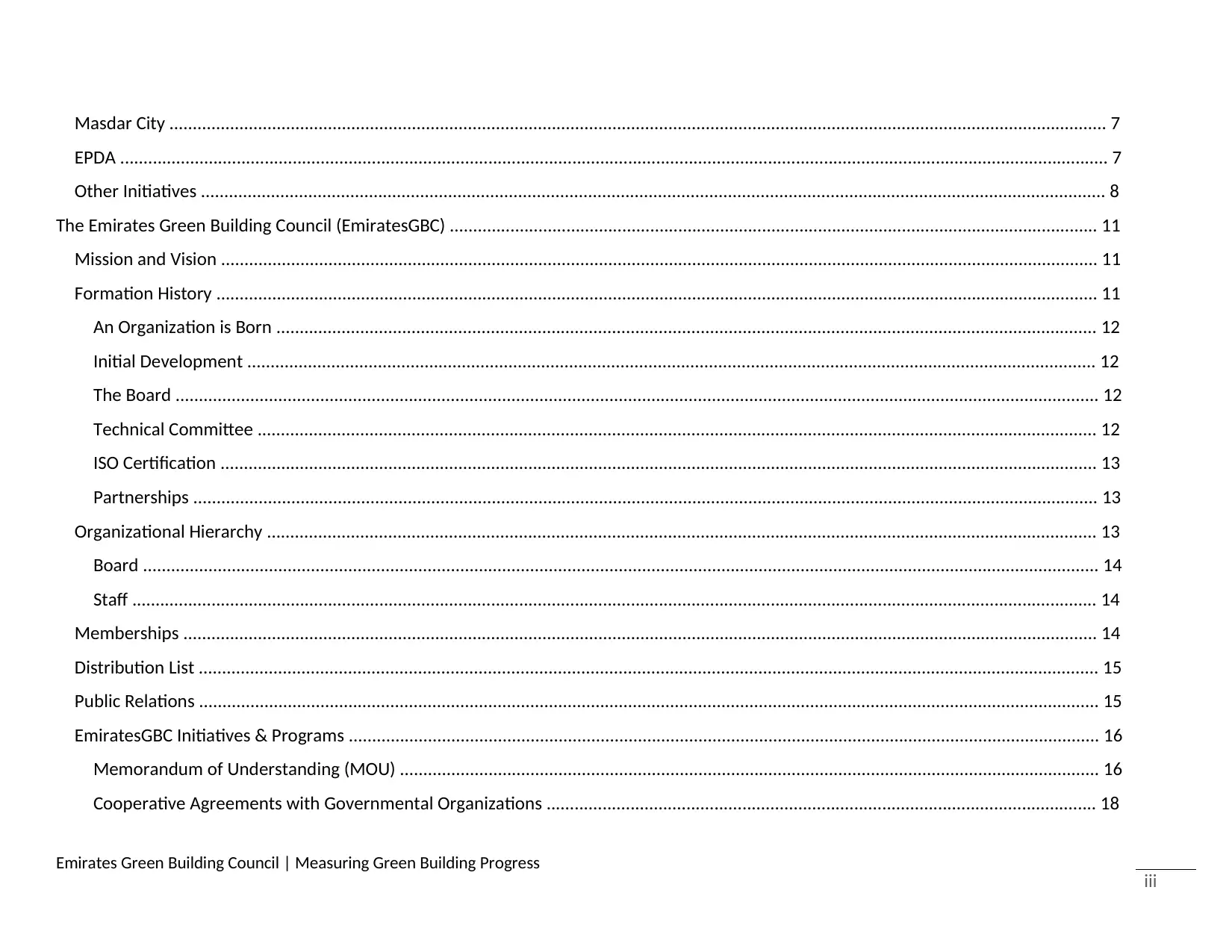
Emirates Green Building Council | Measuring Green Building Progress
iii
Masdar City ......................................................................................................................................................................................................... 7
EPDA .................................................................................................................................................................................................................... 7
Other Initiatives .................................................................................................................................................................................................. 8
The Emirates Green Building Council (EmiratesGBC) ........................................................................................................................................... 11
Mission and Vision ............................................................................................................................................................................................ 11
Formation History ............................................................................................................................................................................................. 11
An Organization is Born ................................................................................................................................................................................ 12
Initial Development ...................................................................................................................................................................................... 12
The Board ...................................................................................................................................................................................................... 12
Technical Committee .................................................................................................................................................................................... 12
ISO Certification ............................................................................................................................................................................................ 13
Partnerships .................................................................................................................................................................................................. 13
Organizational Hierarchy .................................................................................................................................................................................. 13
Board ............................................................................................................................................................................................................. 14
Staff ............................................................................................................................................................................................................... 14
Memberships .................................................................................................................................................................................................... 14
Distribution List ................................................................................................................................................................................................. 15
Public Relations ................................................................................................................................................................................................. 15
EmiratesGBC Initiatives & Programs ................................................................................................................................................................. 16
Memorandum of Understanding (MOU) ...................................................................................................................................................... 16
Cooperative Agreements with Governmental Organizations ...................................................................................................................... 18
iii
Masdar City ......................................................................................................................................................................................................... 7
EPDA .................................................................................................................................................................................................................... 7
Other Initiatives .................................................................................................................................................................................................. 8
The Emirates Green Building Council (EmiratesGBC) ........................................................................................................................................... 11
Mission and Vision ............................................................................................................................................................................................ 11
Formation History ............................................................................................................................................................................................. 11
An Organization is Born ................................................................................................................................................................................ 12
Initial Development ...................................................................................................................................................................................... 12
The Board ...................................................................................................................................................................................................... 12
Technical Committee .................................................................................................................................................................................... 12
ISO Certification ............................................................................................................................................................................................ 13
Partnerships .................................................................................................................................................................................................. 13
Organizational Hierarchy .................................................................................................................................................................................. 13
Board ............................................................................................................................................................................................................. 14
Staff ............................................................................................................................................................................................................... 14
Memberships .................................................................................................................................................................................................... 14
Distribution List ................................................................................................................................................................................................. 15
Public Relations ................................................................................................................................................................................................. 15
EmiratesGBC Initiatives & Programs ................................................................................................................................................................. 16
Memorandum of Understanding (MOU) ...................................................................................................................................................... 16
Cooperative Agreements with Governmental Organizations ...................................................................................................................... 18
⊘ This is a preview!⊘
Do you want full access?
Subscribe today to unlock all pages.

Trusted by 1+ million students worldwide
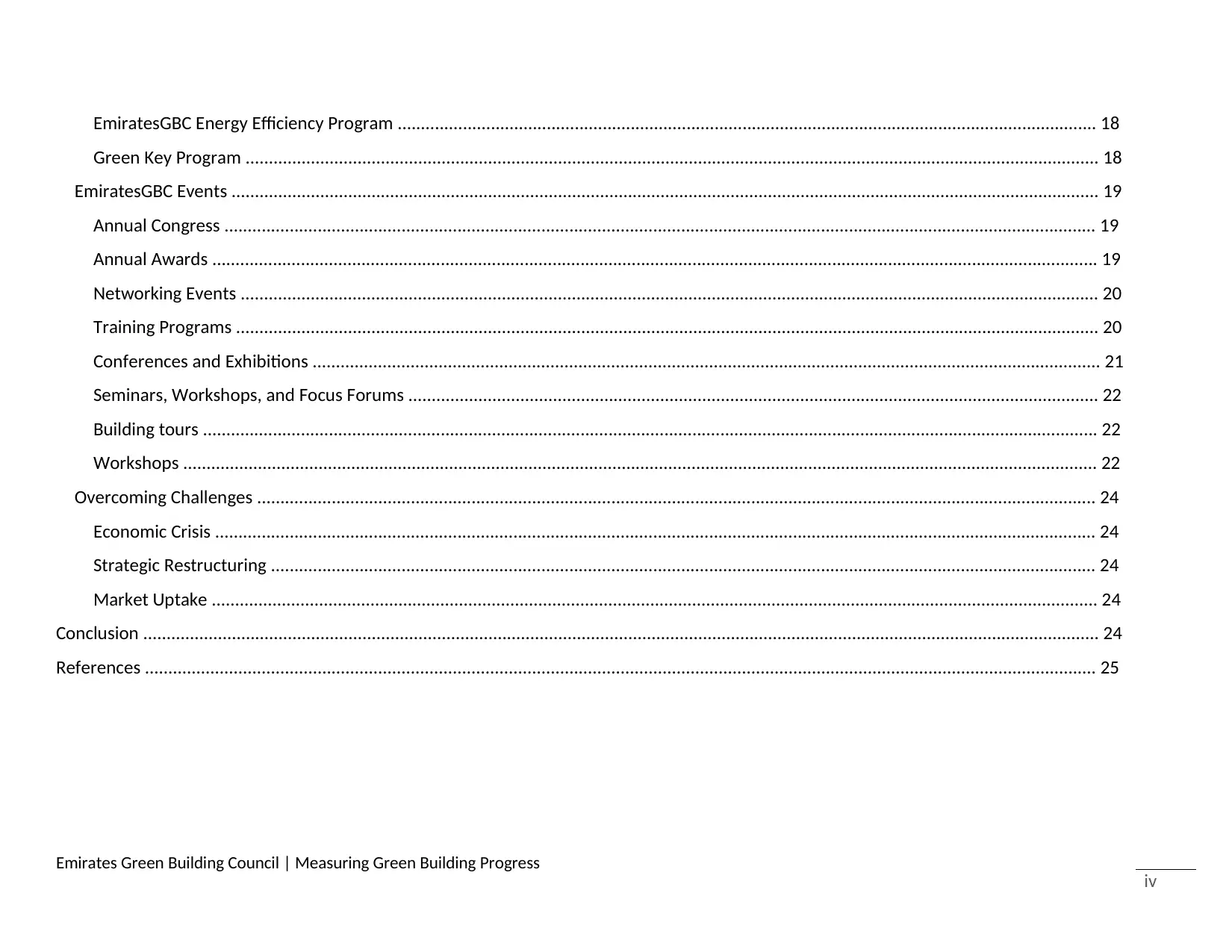
Emirates Green Building Council | Measuring Green Building Progress
iv
EmiratesGBC Energy Efficiency Program ...................................................................................................................................................... 18
Green Key Program ....................................................................................................................................................................................... 18
EmiratesGBC Events .......................................................................................................................................................................................... 19
Annual Congress ........................................................................................................................................................................................... 19
Annual Awards .............................................................................................................................................................................................. 19
Networking Events ........................................................................................................................................................................................ 20
Training Programs ......................................................................................................................................................................................... 20
Conferences and Exhibitions ......................................................................................................................................................................... 21
Seminars, Workshops, and Focus Forums .................................................................................................................................................... 22
Building tours ................................................................................................................................................................................................ 22
Workshops .................................................................................................................................................................................................... 22
Overcoming Challenges .................................................................................................................................................................................... 24
Economic Crisis ............................................................................................................................................................................................. 24
Strategic Restructuring ................................................................................................................................................................................. 24
Market Uptake .............................................................................................................................................................................................. 24
Conclusion ............................................................................................................................................................................................................. 24
References ............................................................................................................................................................................................................ 25
iv
EmiratesGBC Energy Efficiency Program ...................................................................................................................................................... 18
Green Key Program ....................................................................................................................................................................................... 18
EmiratesGBC Events .......................................................................................................................................................................................... 19
Annual Congress ........................................................................................................................................................................................... 19
Annual Awards .............................................................................................................................................................................................. 19
Networking Events ........................................................................................................................................................................................ 20
Training Programs ......................................................................................................................................................................................... 20
Conferences and Exhibitions ......................................................................................................................................................................... 21
Seminars, Workshops, and Focus Forums .................................................................................................................................................... 22
Building tours ................................................................................................................................................................................................ 22
Workshops .................................................................................................................................................................................................... 22
Overcoming Challenges .................................................................................................................................................................................... 24
Economic Crisis ............................................................................................................................................................................................. 24
Strategic Restructuring ................................................................................................................................................................................. 24
Market Uptake .............................................................................................................................................................................................. 24
Conclusion ............................................................................................................................................................................................................. 24
References ............................................................................................................................................................................................................ 25
Paraphrase This Document
Need a fresh take? Get an instant paraphrase of this document with our AI Paraphraser
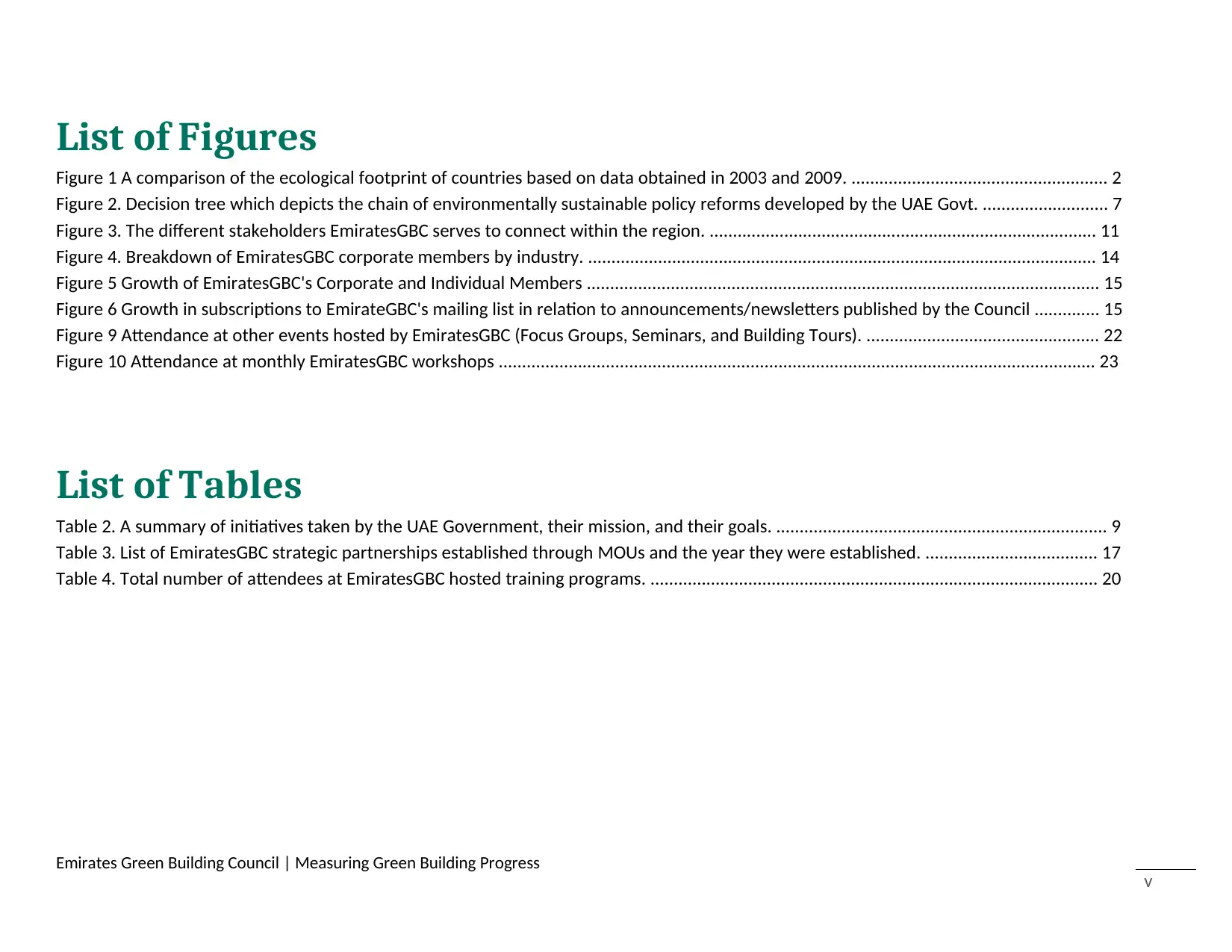
Emirates Green Building Council | Measuring Green Building Progress
v
List of Figures
Figure 1 A comparison of the ecological footprint of countries based on data obtained in 2003 and 2009. ....................................................... 2
Figure 2. Decision tree which depicts the chain of environmentally sustainable policy reforms developed by the UAE Govt. ........................... 7
Figure 3. The different stakeholders EmiratesGBC serves to connect within the region. ................................................................................... 11
Figure 4. Breakdown of EmiratesGBC corporate members by industry. ............................................................................................................. 14
Figure 5 Growth of EmiratesGBC's Corporate and Individual Members .............................................................................................................. 15
Figure 6 Growth in subscriptions to EmirateGBC's mailing list in relation to announcements/newsletters published by the Council .............. 15
Figure 9 Attendance at other events hosted by EmiratesGBC (Focus Groups, Seminars, and Building Tours). .................................................. 22
Figure 10 Attendance at monthly EmiratesGBC workshops ................................................................................................................................ 23
List of Tables
Table 2. A summary of initiatives taken by the UAE Government, their mission, and their goals. ....................................................................... 9
Table 3. List of EmiratesGBC strategic partnerships established through MOUs and the year they were established. ..................................... 17
Table 4. Total number of attendees at EmiratesGBC hosted training programs. ................................................................................................ 20
v
List of Figures
Figure 1 A comparison of the ecological footprint of countries based on data obtained in 2003 and 2009. ....................................................... 2
Figure 2. Decision tree which depicts the chain of environmentally sustainable policy reforms developed by the UAE Govt. ........................... 7
Figure 3. The different stakeholders EmiratesGBC serves to connect within the region. ................................................................................... 11
Figure 4. Breakdown of EmiratesGBC corporate members by industry. ............................................................................................................. 14
Figure 5 Growth of EmiratesGBC's Corporate and Individual Members .............................................................................................................. 15
Figure 6 Growth in subscriptions to EmirateGBC's mailing list in relation to announcements/newsletters published by the Council .............. 15
Figure 9 Attendance at other events hosted by EmiratesGBC (Focus Groups, Seminars, and Building Tours). .................................................. 22
Figure 10 Attendance at monthly EmiratesGBC workshops ................................................................................................................................ 23
List of Tables
Table 2. A summary of initiatives taken by the UAE Government, their mission, and their goals. ....................................................................... 9
Table 3. List of EmiratesGBC strategic partnerships established through MOUs and the year they were established. ..................................... 17
Table 4. Total number of attendees at EmiratesGBC hosted training programs. ................................................................................................ 20
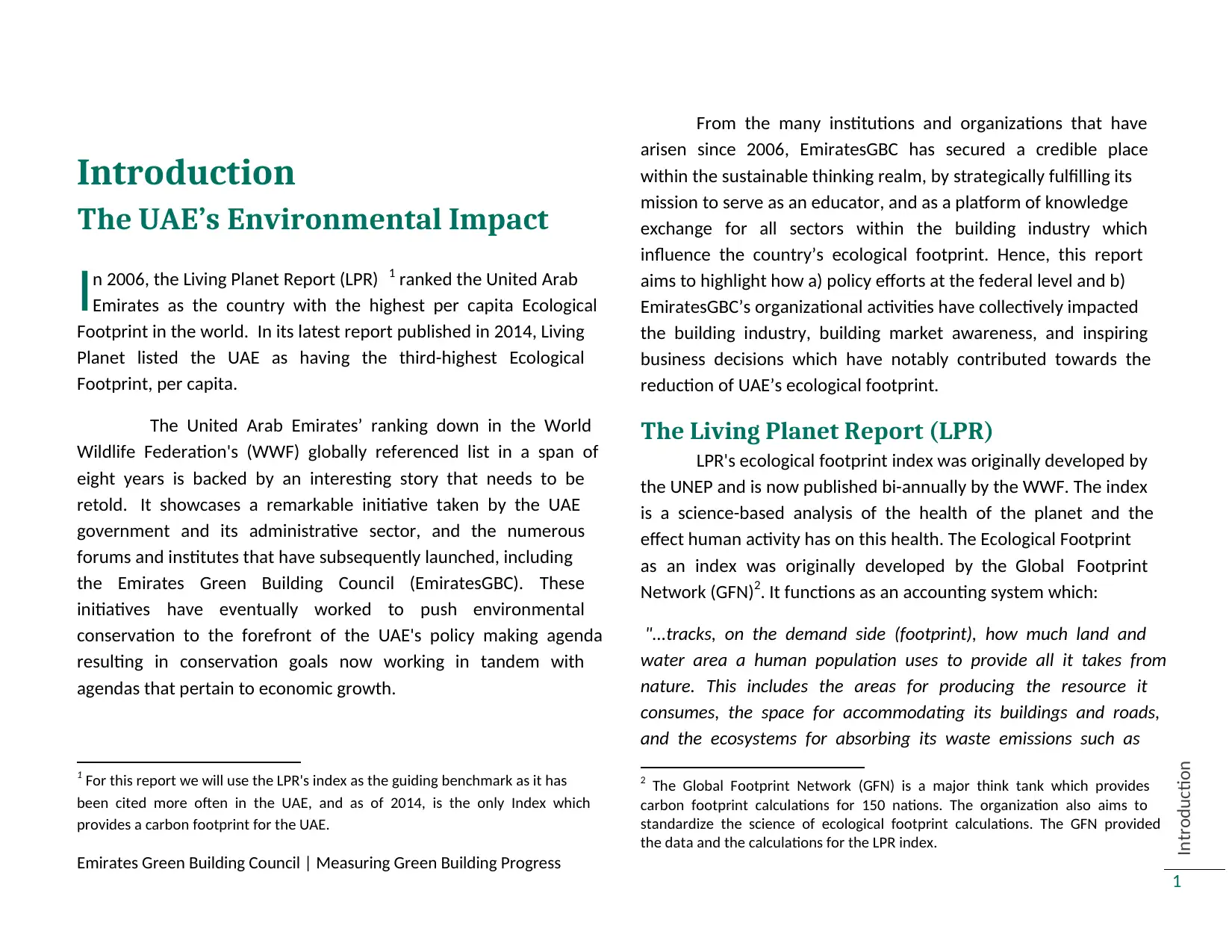
Emirates Green Building Council | Measuring Green Building Progress
Introduction
1
Introduction
The UAE’s Environmental Impact
n 2006, the Living Planet Report (LPR) 1 ranked the United Arab
Emirates as the country with the highest per capita Ecological
Footprint in the world. In its latest report published in 2014, Living
Planet listed the UAE as having the third-highest Ecological
Footprint, per capita.
The United Arab Emirates’ ranking down in the World
Wildlife Federation's (WWF) globally referenced list in a span of
eight years is backed by an interesting story that needs to be
retold. It showcases a remarkable initiative taken by the UAE
government and its administrative sector, and the numerous
forums and institutes that have subsequently launched, including
the Emirates Green Building Council (EmiratesGBC). These
initiatives have eventually worked to push environmental
conservation to the forefront of the UAE's policy making agenda
resulting in conservation goals now working in tandem with
agendas that pertain to economic growth.
1 For this report we will use the LPR's index as the guiding benchmark as it has
been cited more often in the UAE, and as of 2014, is the only Index which
provides a carbon footprint for the UAE.
From the many institutions and organizations that have
arisen since 2006, EmiratesGBC has secured a credible place
within the sustainable thinking realm, by strategically fulfilling its
mission to serve as an educator, and as a platform of knowledge
exchange for all sectors within the building industry which
influence the country’s ecological footprint. Hence, this report
aims to highlight how a) policy efforts at the federal level and b)
EmiratesGBC’s organizational activities have collectively impacted
the building industry, building market awareness, and inspiring
business decisions which have notably contributed towards the
reduction of UAE’s ecological footprint.
The Living Planet Report (LPR)
LPR's ecological footprint index was originally developed by
the UNEP and is now published bi-annually by the WWF. The index
is a science-based analysis of the health of the planet and the
effect human activity has on this health. The Ecological Footprint
as an index was originally developed by the Global Footprint
Network (GFN)2. It functions as an accounting system which:
"...tracks, on the demand side (footprint), how much land and
water area a human population uses to provide all it takes from
nature. This includes the areas for producing the resource it
consumes, the space for accommodating its buildings and roads,
and the ecosystems for absorbing its waste emissions such as
2 The Global Footprint Network (GFN) is a major think tank which provides
carbon footprint calculations for 150 nations. The organization also aims to
standardize the science of ecological footprint calculations. The GFN provided
the data and the calculations for the LPR index.
I
Introduction
1
Introduction
The UAE’s Environmental Impact
n 2006, the Living Planet Report (LPR) 1 ranked the United Arab
Emirates as the country with the highest per capita Ecological
Footprint in the world. In its latest report published in 2014, Living
Planet listed the UAE as having the third-highest Ecological
Footprint, per capita.
The United Arab Emirates’ ranking down in the World
Wildlife Federation's (WWF) globally referenced list in a span of
eight years is backed by an interesting story that needs to be
retold. It showcases a remarkable initiative taken by the UAE
government and its administrative sector, and the numerous
forums and institutes that have subsequently launched, including
the Emirates Green Building Council (EmiratesGBC). These
initiatives have eventually worked to push environmental
conservation to the forefront of the UAE's policy making agenda
resulting in conservation goals now working in tandem with
agendas that pertain to economic growth.
1 For this report we will use the LPR's index as the guiding benchmark as it has
been cited more often in the UAE, and as of 2014, is the only Index which
provides a carbon footprint for the UAE.
From the many institutions and organizations that have
arisen since 2006, EmiratesGBC has secured a credible place
within the sustainable thinking realm, by strategically fulfilling its
mission to serve as an educator, and as a platform of knowledge
exchange for all sectors within the building industry which
influence the country’s ecological footprint. Hence, this report
aims to highlight how a) policy efforts at the federal level and b)
EmiratesGBC’s organizational activities have collectively impacted
the building industry, building market awareness, and inspiring
business decisions which have notably contributed towards the
reduction of UAE’s ecological footprint.
The Living Planet Report (LPR)
LPR's ecological footprint index was originally developed by
the UNEP and is now published bi-annually by the WWF. The index
is a science-based analysis of the health of the planet and the
effect human activity has on this health. The Ecological Footprint
as an index was originally developed by the Global Footprint
Network (GFN)2. It functions as an accounting system which:
"...tracks, on the demand side (footprint), how much land and
water area a human population uses to provide all it takes from
nature. This includes the areas for producing the resource it
consumes, the space for accommodating its buildings and roads,
and the ecosystems for absorbing its waste emissions such as
2 The Global Footprint Network (GFN) is a major think tank which provides
carbon footprint calculations for 150 nations. The organization also aims to
standardize the science of ecological footprint calculations. The GFN provided
the data and the calculations for the LPR index.
I
⊘ This is a preview!⊘
Do you want full access?
Subscribe today to unlock all pages.

Trusted by 1+ million students worldwide
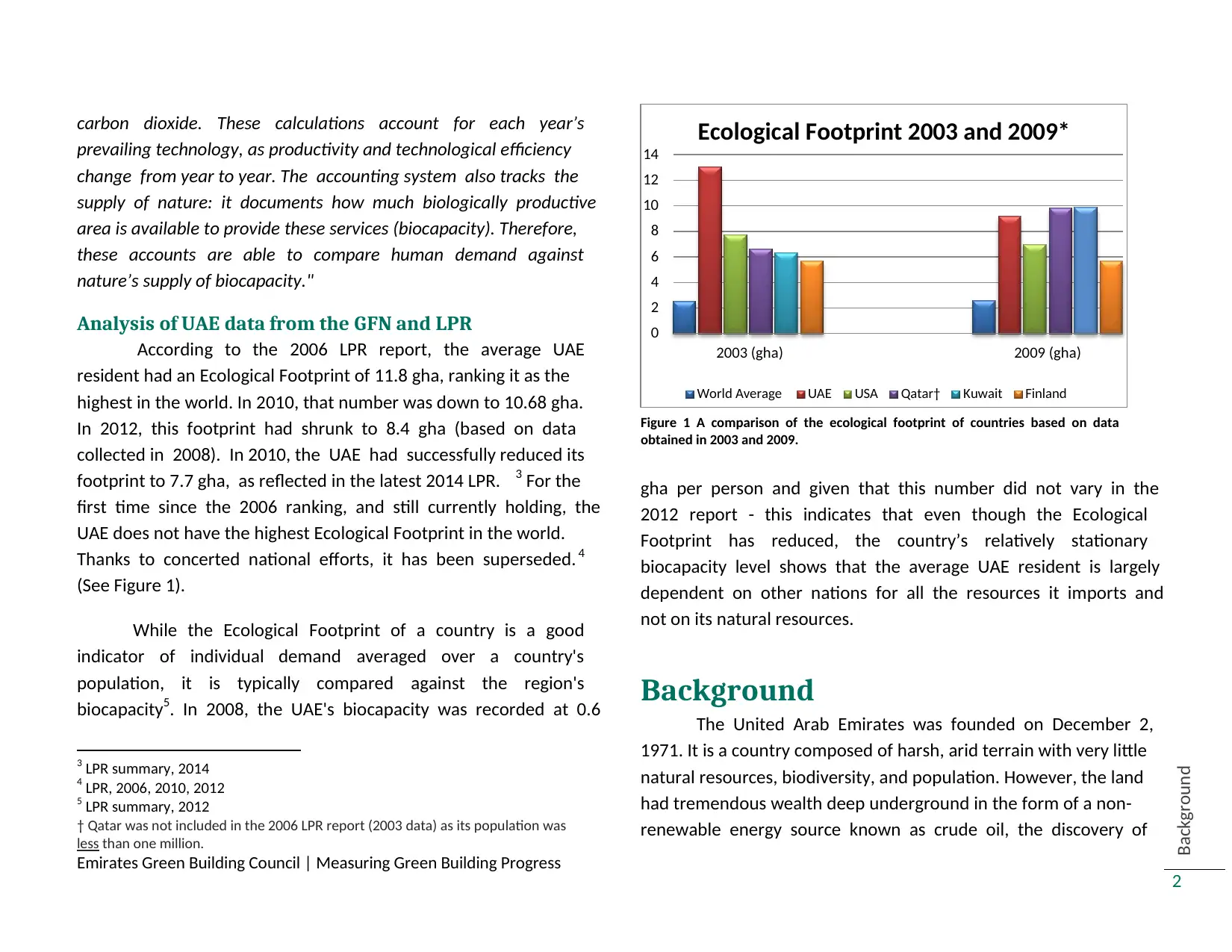
Emirates Green Building Council | Measuring Green Building Progress
Background
2
0
2
4
6
8
10
12
14
2003 (gha) 2009 (gha)
Ecological Footprint 2003 and 2009*
World Average UAE USA Qatar† Kuwait Finland
carbon dioxide. These calculations account for each year’s
prevailing technology, as productivity and technological efficiency
change from year to year. The accounting system also tracks the
supply of nature: it documents how much biologically productive
area is available to provide these services (biocapacity). Therefore,
these accounts are able to compare human demand against
nature’s supply of biocapacity."
Analysis of UAE data from the GFN and LPR
According to the 2006 LPR report, the average UAE
resident had an Ecological Footprint of 11.8 gha, ranking it as the
highest in the world. In 2010, that number was down to 10.68 gha.
In 2012, this footprint had shrunk to 8.4 gha (based on data
collected in 2008). In 2010, the UAE had successfully reduced its
footprint to 7.7 gha, as reflected in the latest 2014 LPR. 3 For the
first time since the 2006 ranking, and still currently holding, the
UAE does not have the highest Ecological Footprint in the world.
Thanks to concerted national efforts, it has been superseded. 4
(See Figure 1).
While the Ecological Footprint of a country is a good
indicator of individual demand averaged over a country's
population, it is typically compared against the region's
biocapacity5. In 2008, the UAE's biocapacity was recorded at 0.6
3 LPR summary, 2014
4 LPR, 2006, 2010, 2012
5 LPR summary, 2012
† Qatar was not included in the 2006 LPR report (2003 data) as its population was
less than one million.
gha per person and given that this number did not vary in the
2012 report - this indicates that even though the Ecological
Footprint has reduced, the country’s relatively stationary
biocapacity level shows that the average UAE resident is largely
dependent on other nations for all the resources it imports and
not on its natural resources.
Background
The United Arab Emirates was founded on December 2,
1971. It is a country composed of harsh, arid terrain with very little
natural resources, biodiversity, and population. However, the land
had tremendous wealth deep underground in the form of a non-
renewable energy source known as crude oil, the discovery of
Figure 1 A comparison of the ecological footprint of countries based on data
obtained in 2003 and 2009.
Background
2
0
2
4
6
8
10
12
14
2003 (gha) 2009 (gha)
Ecological Footprint 2003 and 2009*
World Average UAE USA Qatar† Kuwait Finland
carbon dioxide. These calculations account for each year’s
prevailing technology, as productivity and technological efficiency
change from year to year. The accounting system also tracks the
supply of nature: it documents how much biologically productive
area is available to provide these services (biocapacity). Therefore,
these accounts are able to compare human demand against
nature’s supply of biocapacity."
Analysis of UAE data from the GFN and LPR
According to the 2006 LPR report, the average UAE
resident had an Ecological Footprint of 11.8 gha, ranking it as the
highest in the world. In 2010, that number was down to 10.68 gha.
In 2012, this footprint had shrunk to 8.4 gha (based on data
collected in 2008). In 2010, the UAE had successfully reduced its
footprint to 7.7 gha, as reflected in the latest 2014 LPR. 3 For the
first time since the 2006 ranking, and still currently holding, the
UAE does not have the highest Ecological Footprint in the world.
Thanks to concerted national efforts, it has been superseded. 4
(See Figure 1).
While the Ecological Footprint of a country is a good
indicator of individual demand averaged over a country's
population, it is typically compared against the region's
biocapacity5. In 2008, the UAE's biocapacity was recorded at 0.6
3 LPR summary, 2014
4 LPR, 2006, 2010, 2012
5 LPR summary, 2012
† Qatar was not included in the 2006 LPR report (2003 data) as its population was
less than one million.
gha per person and given that this number did not vary in the
2012 report - this indicates that even though the Ecological
Footprint has reduced, the country’s relatively stationary
biocapacity level shows that the average UAE resident is largely
dependent on other nations for all the resources it imports and
not on its natural resources.
Background
The United Arab Emirates was founded on December 2,
1971. It is a country composed of harsh, arid terrain with very little
natural resources, biodiversity, and population. However, the land
had tremendous wealth deep underground in the form of a non-
renewable energy source known as crude oil, the discovery of
Figure 1 A comparison of the ecological footprint of countries based on data
obtained in 2003 and 2009.
Paraphrase This Document
Need a fresh take? Get an instant paraphrase of this document with our AI Paraphraser
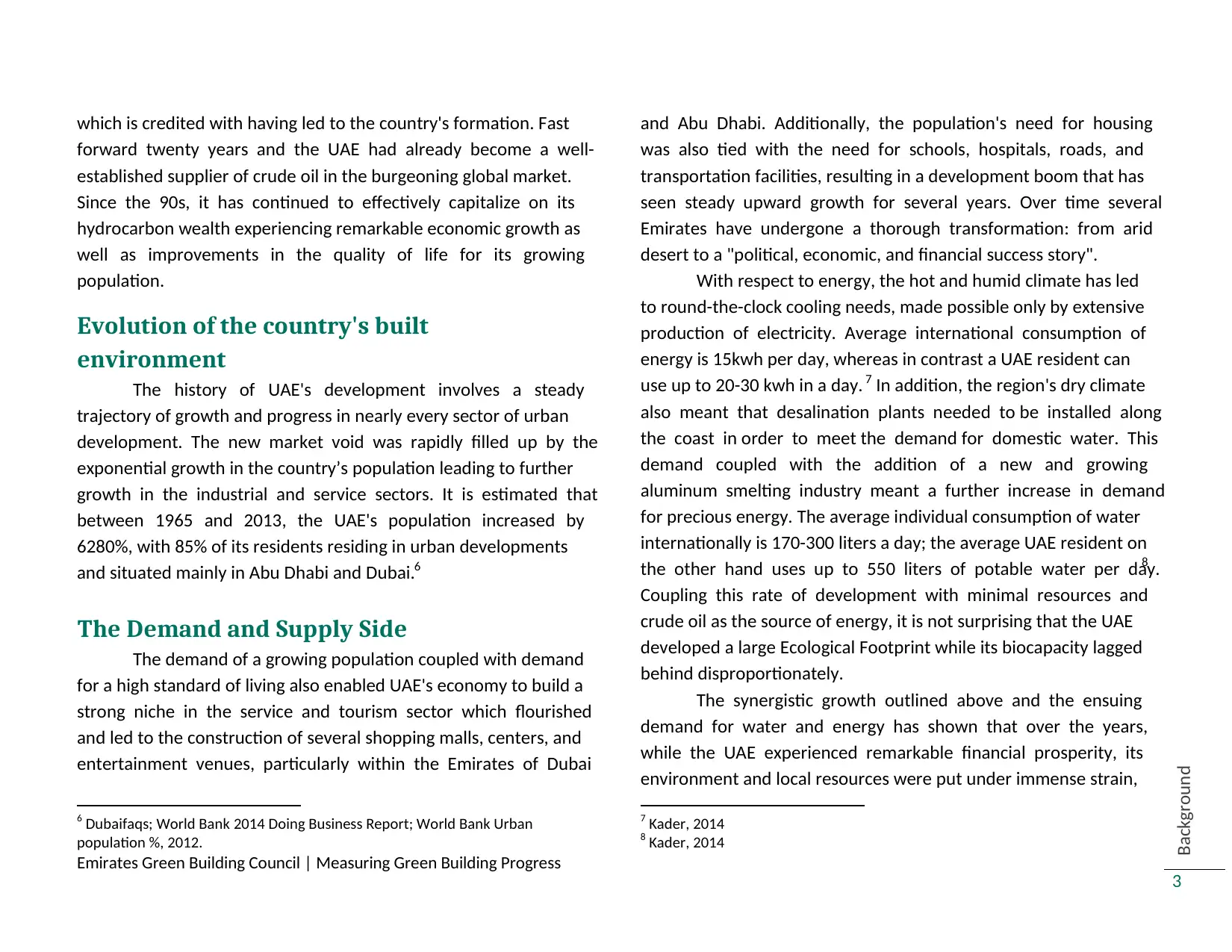
Emirates Green Building Council | Measuring Green Building Progress
Background
3
which is credited with having led to the country's formation. Fast
forward twenty years and the UAE had already become a well-
established supplier of crude oil in the burgeoning global market.
Since the 90s, it has continued to effectively capitalize on its
hydrocarbon wealth experiencing remarkable economic growth as
well as improvements in the quality of life for its growing
population.
Evolution of the country's built
environment
The history of UAE's development involves a steady
trajectory of growth and progress in nearly every sector of urban
development. The new market void was rapidly filled up by the
exponential growth in the country’s population leading to further
growth in the industrial and service sectors. It is estimated that
between 1965 and 2013, the UAE's population increased by
6280%, with 85% of its residents residing in urban developments
and situated mainly in Abu Dhabi and Dubai.6
The Demand and Supply Side
The demand of a growing population coupled with demand
for a high standard of living also enabled UAE's economy to build a
strong niche in the service and tourism sector which flourished
and led to the construction of several shopping malls, centers, and
entertainment venues, particularly within the Emirates of Dubai
6 Dubaifaqs; World Bank 2014 Doing Business Report; World Bank Urban
population %, 2012.
and Abu Dhabi. Additionally, the population's need for housing
was also tied with the need for schools, hospitals, roads, and
transportation facilities, resulting in a development boom that has
seen steady upward growth for several years. Over time several
Emirates have undergone a thorough transformation: from arid
desert to a "political, economic, and financial success story".
With respect to energy, the hot and humid climate has led
to round-the-clock cooling needs, made possible only by extensive
production of electricity. Average international consumption of
energy is 15kwh per day, whereas in contrast a UAE resident can
use up to 20-30 kwh in a day. 7 In addition, the region's dry climate
also meant that desalination plants needed to be installed along
the coast in order to meet the demand for domestic water. This
demand coupled with the addition of a new and growing
aluminum smelting industry meant a further increase in demand
for precious energy. The average individual consumption of water
internationally is 170-300 liters a day; the average UAE resident on
the other hand uses up to 550 liters of potable water per day.8
Coupling this rate of development with minimal resources and
crude oil as the source of energy, it is not surprising that the UAE
developed a large Ecological Footprint while its biocapacity lagged
behind disproportionately.
The synergistic growth outlined above and the ensuing
demand for water and energy has shown that over the years,
while the UAE experienced remarkable financial prosperity, its
environment and local resources were put under immense strain,
7 Kader, 2014
8 Kader, 2014
Background
3
which is credited with having led to the country's formation. Fast
forward twenty years and the UAE had already become a well-
established supplier of crude oil in the burgeoning global market.
Since the 90s, it has continued to effectively capitalize on its
hydrocarbon wealth experiencing remarkable economic growth as
well as improvements in the quality of life for its growing
population.
Evolution of the country's built
environment
The history of UAE's development involves a steady
trajectory of growth and progress in nearly every sector of urban
development. The new market void was rapidly filled up by the
exponential growth in the country’s population leading to further
growth in the industrial and service sectors. It is estimated that
between 1965 and 2013, the UAE's population increased by
6280%, with 85% of its residents residing in urban developments
and situated mainly in Abu Dhabi and Dubai.6
The Demand and Supply Side
The demand of a growing population coupled with demand
for a high standard of living also enabled UAE's economy to build a
strong niche in the service and tourism sector which flourished
and led to the construction of several shopping malls, centers, and
entertainment venues, particularly within the Emirates of Dubai
6 Dubaifaqs; World Bank 2014 Doing Business Report; World Bank Urban
population %, 2012.
and Abu Dhabi. Additionally, the population's need for housing
was also tied with the need for schools, hospitals, roads, and
transportation facilities, resulting in a development boom that has
seen steady upward growth for several years. Over time several
Emirates have undergone a thorough transformation: from arid
desert to a "political, economic, and financial success story".
With respect to energy, the hot and humid climate has led
to round-the-clock cooling needs, made possible only by extensive
production of electricity. Average international consumption of
energy is 15kwh per day, whereas in contrast a UAE resident can
use up to 20-30 kwh in a day. 7 In addition, the region's dry climate
also meant that desalination plants needed to be installed along
the coast in order to meet the demand for domestic water. This
demand coupled with the addition of a new and growing
aluminum smelting industry meant a further increase in demand
for precious energy. The average individual consumption of water
internationally is 170-300 liters a day; the average UAE resident on
the other hand uses up to 550 liters of potable water per day.8
Coupling this rate of development with minimal resources and
crude oil as the source of energy, it is not surprising that the UAE
developed a large Ecological Footprint while its biocapacity lagged
behind disproportionately.
The synergistic growth outlined above and the ensuing
demand for water and energy has shown that over the years,
while the UAE experienced remarkable financial prosperity, its
environment and local resources were put under immense strain,
7 Kader, 2014
8 Kader, 2014
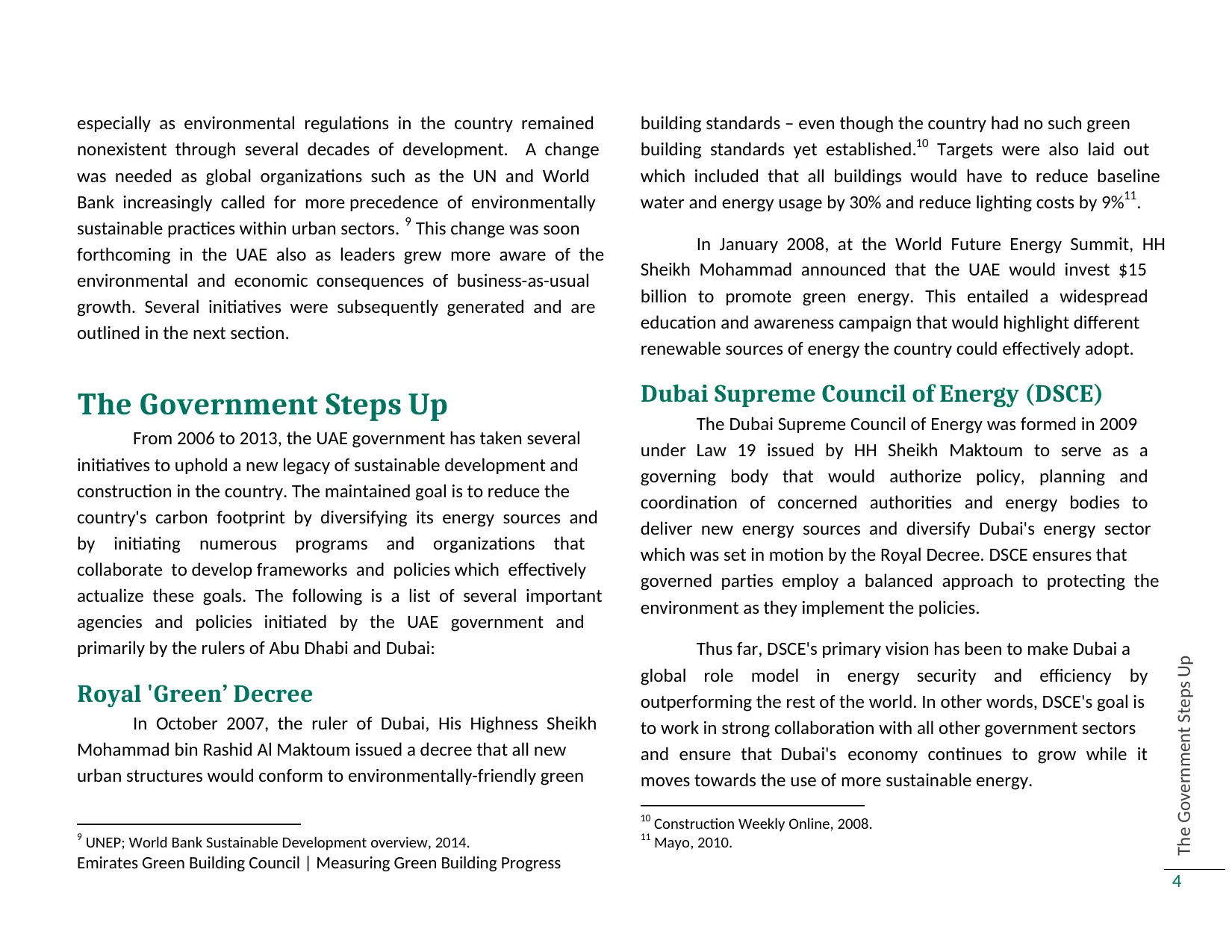
Emirates Green Building Council | Measuring Green Building Progress
The Government Steps Up
4
especially as environmental regulations in the country remained
nonexistent through several decades of development. A change
was needed as global organizations such as the UN and World
Bank increasingly called for more precedence of environmentally
sustainable practices within urban sectors. 9 This change was soon
forthcoming in the UAE also as leaders grew more aware of the
environmental and economic consequences of business-as-usual
growth. Several initiatives were subsequently generated and are
outlined in the next section.
The Government Steps Up
From 2006 to 2013, the UAE government has taken several
initiatives to uphold a new legacy of sustainable development and
construction in the country. The maintained goal is to reduce the
country's carbon footprint by diversifying its energy sources and
by initiating numerous programs and organizations that
collaborate to develop frameworks and policies which effectively
actualize these goals. The following is a list of several important
agencies and policies initiated by the UAE government and
primarily by the rulers of Abu Dhabi and Dubai:
Royal 'Green’ Decree
In October 2007, the ruler of Dubai, His Highness Sheikh
Mohammad bin Rashid Al Maktoum issued a decree that all new
urban structures would conform to environmentally-friendly green
9 UNEP; World Bank Sustainable Development overview, 2014.
building standards – even though the country had no such green
building standards yet established.10 Targets were also laid out
which included that all buildings would have to reduce baseline
water and energy usage by 30% and reduce lighting costs by 9%11.
In January 2008, at the World Future Energy Summit, HH
Sheikh Mohammad announced that the UAE would invest $15
billion to promote green energy. This entailed a widespread
education and awareness campaign that would highlight different
renewable sources of energy the country could effectively adopt.
Dubai Supreme Council of Energy (DSCE)
The Dubai Supreme Council of Energy was formed in 2009
under Law 19 issued by HH Sheikh Maktoum to serve as a
governing body that would authorize policy, planning and
coordination of concerned authorities and energy bodies to
deliver new energy sources and diversify Dubai's energy sector
which was set in motion by the Royal Decree. DSCE ensures that
governed parties employ a balanced approach to protecting the
environment as they implement the policies.
Thus far, DSCE's primary vision has been to make Dubai a
global role model in energy security and efficiency by
outperforming the rest of the world. In other words, DSCE's goal is
to work in strong collaboration with all other government sectors
and ensure that Dubai's economy continues to grow while it
moves towards the use of more sustainable energy.
10 Construction Weekly Online, 2008.
11 Mayo, 2010.
The Government Steps Up
4
especially as environmental regulations in the country remained
nonexistent through several decades of development. A change
was needed as global organizations such as the UN and World
Bank increasingly called for more precedence of environmentally
sustainable practices within urban sectors. 9 This change was soon
forthcoming in the UAE also as leaders grew more aware of the
environmental and economic consequences of business-as-usual
growth. Several initiatives were subsequently generated and are
outlined in the next section.
The Government Steps Up
From 2006 to 2013, the UAE government has taken several
initiatives to uphold a new legacy of sustainable development and
construction in the country. The maintained goal is to reduce the
country's carbon footprint by diversifying its energy sources and
by initiating numerous programs and organizations that
collaborate to develop frameworks and policies which effectively
actualize these goals. The following is a list of several important
agencies and policies initiated by the UAE government and
primarily by the rulers of Abu Dhabi and Dubai:
Royal 'Green’ Decree
In October 2007, the ruler of Dubai, His Highness Sheikh
Mohammad bin Rashid Al Maktoum issued a decree that all new
urban structures would conform to environmentally-friendly green
9 UNEP; World Bank Sustainable Development overview, 2014.
building standards – even though the country had no such green
building standards yet established.10 Targets were also laid out
which included that all buildings would have to reduce baseline
water and energy usage by 30% and reduce lighting costs by 9%11.
In January 2008, at the World Future Energy Summit, HH
Sheikh Mohammad announced that the UAE would invest $15
billion to promote green energy. This entailed a widespread
education and awareness campaign that would highlight different
renewable sources of energy the country could effectively adopt.
Dubai Supreme Council of Energy (DSCE)
The Dubai Supreme Council of Energy was formed in 2009
under Law 19 issued by HH Sheikh Maktoum to serve as a
governing body that would authorize policy, planning and
coordination of concerned authorities and energy bodies to
deliver new energy sources and diversify Dubai's energy sector
which was set in motion by the Royal Decree. DSCE ensures that
governed parties employ a balanced approach to protecting the
environment as they implement the policies.
Thus far, DSCE's primary vision has been to make Dubai a
global role model in energy security and efficiency by
outperforming the rest of the world. In other words, DSCE's goal is
to work in strong collaboration with all other government sectors
and ensure that Dubai's economy continues to grow while it
moves towards the use of more sustainable energy.
10 Construction Weekly Online, 2008.
11 Mayo, 2010.
⊘ This is a preview!⊘
Do you want full access?
Subscribe today to unlock all pages.

Trusted by 1+ million students worldwide
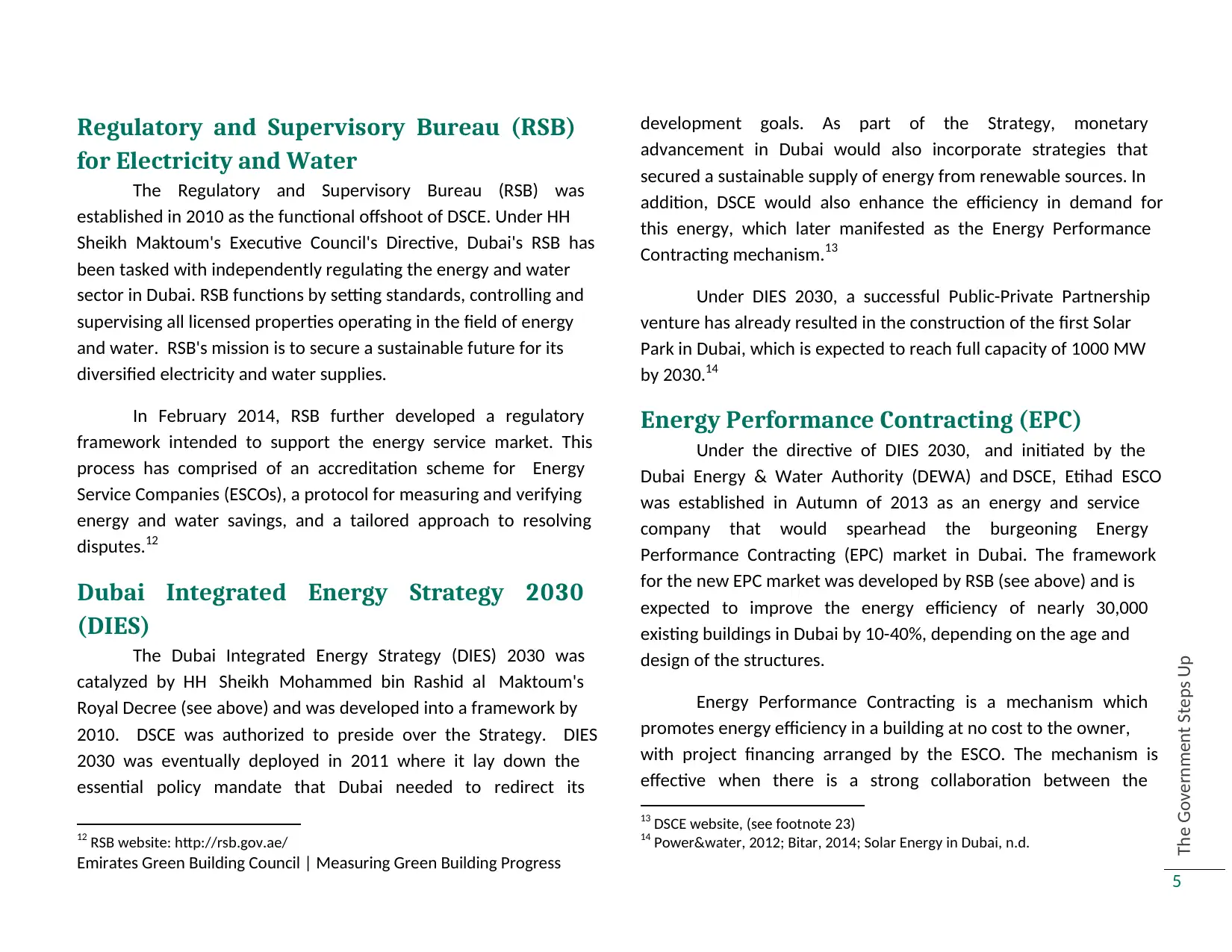
Emirates Green Building Council | Measuring Green Building Progress
The Government Steps Up
5
Regulatory and Supervisory Bureau (RSB)
for Electricity and Water
The Regulatory and Supervisory Bureau (RSB) was
established in 2010 as the functional offshoot of DSCE. Under HH
Sheikh Maktoum's Executive Council's Directive, Dubai's RSB has
been tasked with independently regulating the energy and water
sector in Dubai. RSB functions by setting standards, controlling and
supervising all licensed properties operating in the field of energy
and water. RSB's mission is to secure a sustainable future for its
diversified electricity and water supplies.
In February 2014, RSB further developed a regulatory
framework intended to support the energy service market. This
process has comprised of an accreditation scheme for Energy
Service Companies (ESCOs), a protocol for measuring and verifying
energy and water savings, and a tailored approach to resolving
disputes.12
Dubai Integrated Energy Strategy 2030
(DIES)
The Dubai Integrated Energy Strategy (DIES) 2030 was
catalyzed by HH Sheikh Mohammed bin Rashid al Maktoum's
Royal Decree (see above) and was developed into a framework by
2010. DSCE was authorized to preside over the Strategy. DIES
2030 was eventually deployed in 2011 where it lay down the
essential policy mandate that Dubai needed to redirect its
12 RSB website: http://rsb.gov.ae/
development goals. As part of the Strategy, monetary
advancement in Dubai would also incorporate strategies that
secured a sustainable supply of energy from renewable sources. In
addition, DSCE would also enhance the efficiency in demand for
this energy, which later manifested as the Energy Performance
Contracting mechanism.13
Under DIES 2030, a successful Public-Private Partnership
venture has already resulted in the construction of the first Solar
Park in Dubai, which is expected to reach full capacity of 1000 MW
by 2030.14
Energy Performance Contracting (EPC)
Under the directive of DIES 2030, and initiated by the
Dubai Energy & Water Authority (DEWA) and DSCE, Etihad ESCO
was established in Autumn of 2013 as an energy and service
company that would spearhead the burgeoning Energy
Performance Contracting (EPC) market in Dubai. The framework
for the new EPC market was developed by RSB (see above) and is
expected to improve the energy efficiency of nearly 30,000
existing buildings in Dubai by 10-40%, depending on the age and
design of the structures.
Energy Performance Contracting is a mechanism which
promotes energy efficiency in a building at no cost to the owner,
with project financing arranged by the ESCO. The mechanism is
effective when there is a strong collaboration between the
13 DSCE website, (see footnote 23)
14 Power&water, 2012; Bitar, 2014; Solar Energy in Dubai, n.d.
The Government Steps Up
5
Regulatory and Supervisory Bureau (RSB)
for Electricity and Water
The Regulatory and Supervisory Bureau (RSB) was
established in 2010 as the functional offshoot of DSCE. Under HH
Sheikh Maktoum's Executive Council's Directive, Dubai's RSB has
been tasked with independently regulating the energy and water
sector in Dubai. RSB functions by setting standards, controlling and
supervising all licensed properties operating in the field of energy
and water. RSB's mission is to secure a sustainable future for its
diversified electricity and water supplies.
In February 2014, RSB further developed a regulatory
framework intended to support the energy service market. This
process has comprised of an accreditation scheme for Energy
Service Companies (ESCOs), a protocol for measuring and verifying
energy and water savings, and a tailored approach to resolving
disputes.12
Dubai Integrated Energy Strategy 2030
(DIES)
The Dubai Integrated Energy Strategy (DIES) 2030 was
catalyzed by HH Sheikh Mohammed bin Rashid al Maktoum's
Royal Decree (see above) and was developed into a framework by
2010. DSCE was authorized to preside over the Strategy. DIES
2030 was eventually deployed in 2011 where it lay down the
essential policy mandate that Dubai needed to redirect its
12 RSB website: http://rsb.gov.ae/
development goals. As part of the Strategy, monetary
advancement in Dubai would also incorporate strategies that
secured a sustainable supply of energy from renewable sources. In
addition, DSCE would also enhance the efficiency in demand for
this energy, which later manifested as the Energy Performance
Contracting mechanism.13
Under DIES 2030, a successful Public-Private Partnership
venture has already resulted in the construction of the first Solar
Park in Dubai, which is expected to reach full capacity of 1000 MW
by 2030.14
Energy Performance Contracting (EPC)
Under the directive of DIES 2030, and initiated by the
Dubai Energy & Water Authority (DEWA) and DSCE, Etihad ESCO
was established in Autumn of 2013 as an energy and service
company that would spearhead the burgeoning Energy
Performance Contracting (EPC) market in Dubai. The framework
for the new EPC market was developed by RSB (see above) and is
expected to improve the energy efficiency of nearly 30,000
existing buildings in Dubai by 10-40%, depending on the age and
design of the structures.
Energy Performance Contracting is a mechanism which
promotes energy efficiency in a building at no cost to the owner,
with project financing arranged by the ESCO. The mechanism is
effective when there is a strong collaboration between the
13 DSCE website, (see footnote 23)
14 Power&water, 2012; Bitar, 2014; Solar Energy in Dubai, n.d.
Paraphrase This Document
Need a fresh take? Get an instant paraphrase of this document with our AI Paraphraser
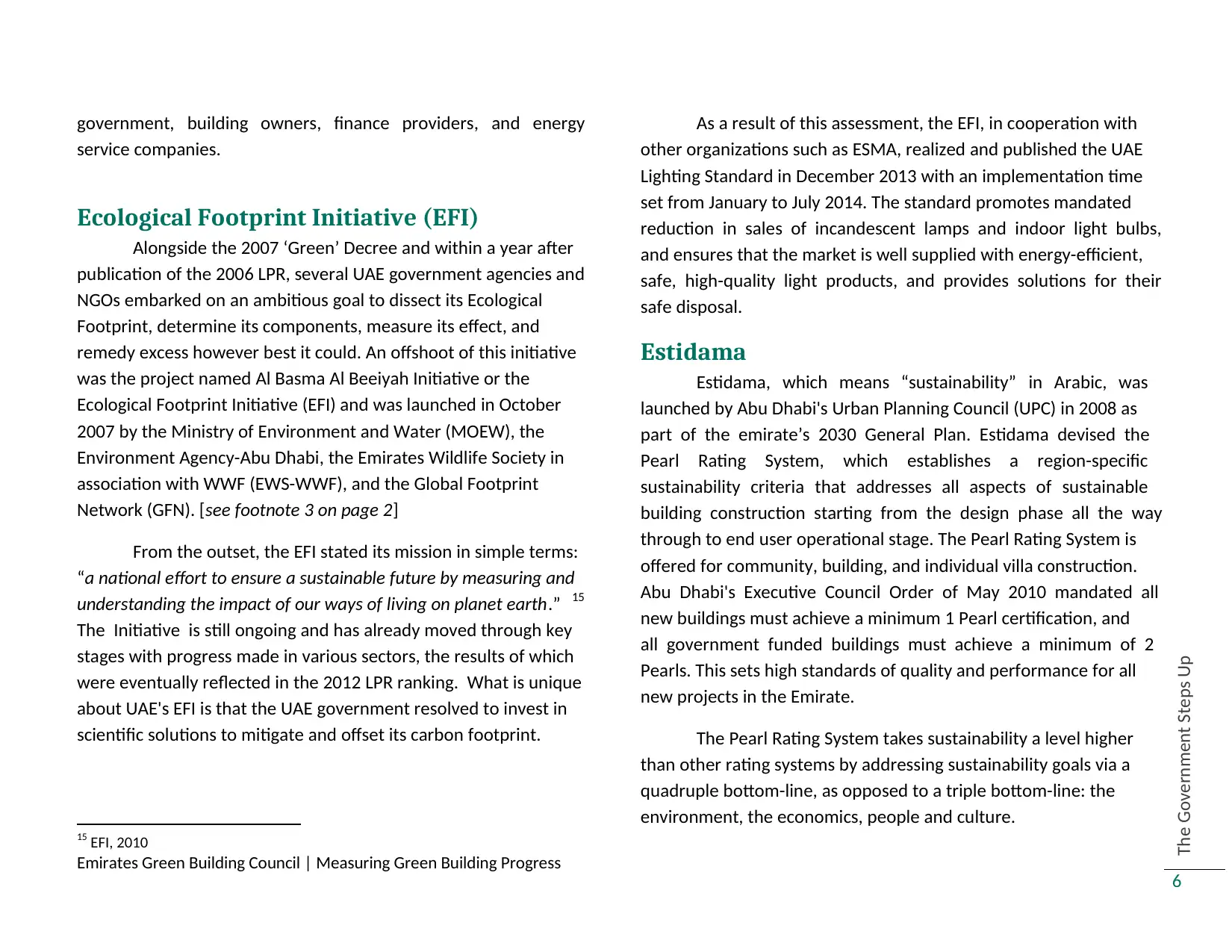
Emirates Green Building Council | Measuring Green Building Progress
The Government Steps Up
6
government, building owners, finance providers, and energy
service companies.
Ecological Footprint Initiative (EFI)
Alongside the 2007 ‘Green’ Decree and within a year after
publication of the 2006 LPR, several UAE government agencies and
NGOs embarked on an ambitious goal to dissect its Ecological
Footprint, determine its components, measure its effect, and
remedy excess however best it could. An offshoot of this initiative
was the project named Al Basma Al Beeiyah Initiative or the
Ecological Footprint Initiative (EFI) and was launched in October
2007 by the Ministry of Environment and Water (MOEW), the
Environment Agency-Abu Dhabi, the Emirates Wildlife Society in
association with WWF (EWS-WWF), and the Global Footprint
Network (GFN). [see footnote 3 on page 2]
From the outset, the EFI stated its mission in simple terms:
“a national effort to ensure a sustainable future by measuring and
understanding the impact of our ways of living on planet earth.” 15
The Initiative is still ongoing and has already moved through key
stages with progress made in various sectors, the results of which
were eventually reflected in the 2012 LPR ranking. What is unique
about UAE's EFI is that the UAE government resolved to invest in
scientific solutions to mitigate and offset its carbon footprint.
15 EFI, 2010
As a result of this assessment, the EFI, in cooperation with
other organizations such as ESMA, realized and published the UAE
Lighting Standard in December 2013 with an implementation time
set from January to July 2014. The standard promotes mandated
reduction in sales of incandescent lamps and indoor light bulbs,
and ensures that the market is well supplied with energy-efficient,
safe, high-quality light products, and provides solutions for their
safe disposal.
Estidama
Estidama, which means “sustainability” in Arabic, was
launched by Abu Dhabi's Urban Planning Council (UPC) in 2008 as
part of the emirate’s 2030 General Plan. Estidama devised the
Pearl Rating System, which establishes a region-specific
sustainability criteria that addresses all aspects of sustainable
building construction starting from the design phase all the way
through to end user operational stage. The Pearl Rating System is
offered for community, building, and individual villa construction.
Abu Dhabi's Executive Council Order of May 2010 mandated all
new buildings must achieve a minimum 1 Pearl certification, and
all government funded buildings must achieve a minimum of 2
Pearls. This sets high standards of quality and performance for all
new projects in the Emirate.
The Pearl Rating System takes sustainability a level higher
than other rating systems by addressing sustainability goals via a
quadruple bottom-line, as opposed to a triple bottom-line: the
environment, the economics, people and culture.
The Government Steps Up
6
government, building owners, finance providers, and energy
service companies.
Ecological Footprint Initiative (EFI)
Alongside the 2007 ‘Green’ Decree and within a year after
publication of the 2006 LPR, several UAE government agencies and
NGOs embarked on an ambitious goal to dissect its Ecological
Footprint, determine its components, measure its effect, and
remedy excess however best it could. An offshoot of this initiative
was the project named Al Basma Al Beeiyah Initiative or the
Ecological Footprint Initiative (EFI) and was launched in October
2007 by the Ministry of Environment and Water (MOEW), the
Environment Agency-Abu Dhabi, the Emirates Wildlife Society in
association with WWF (EWS-WWF), and the Global Footprint
Network (GFN). [see footnote 3 on page 2]
From the outset, the EFI stated its mission in simple terms:
“a national effort to ensure a sustainable future by measuring and
understanding the impact of our ways of living on planet earth.” 15
The Initiative is still ongoing and has already moved through key
stages with progress made in various sectors, the results of which
were eventually reflected in the 2012 LPR ranking. What is unique
about UAE's EFI is that the UAE government resolved to invest in
scientific solutions to mitigate and offset its carbon footprint.
15 EFI, 2010
As a result of this assessment, the EFI, in cooperation with
other organizations such as ESMA, realized and published the UAE
Lighting Standard in December 2013 with an implementation time
set from January to July 2014. The standard promotes mandated
reduction in sales of incandescent lamps and indoor light bulbs,
and ensures that the market is well supplied with energy-efficient,
safe, high-quality light products, and provides solutions for their
safe disposal.
Estidama
Estidama, which means “sustainability” in Arabic, was
launched by Abu Dhabi's Urban Planning Council (UPC) in 2008 as
part of the emirate’s 2030 General Plan. Estidama devised the
Pearl Rating System, which establishes a region-specific
sustainability criteria that addresses all aspects of sustainable
building construction starting from the design phase all the way
through to end user operational stage. The Pearl Rating System is
offered for community, building, and individual villa construction.
Abu Dhabi's Executive Council Order of May 2010 mandated all
new buildings must achieve a minimum 1 Pearl certification, and
all government funded buildings must achieve a minimum of 2
Pearls. This sets high standards of quality and performance for all
new projects in the Emirate.
The Pearl Rating System takes sustainability a level higher
than other rating systems by addressing sustainability goals via a
quadruple bottom-line, as opposed to a triple bottom-line: the
environment, the economics, people and culture.
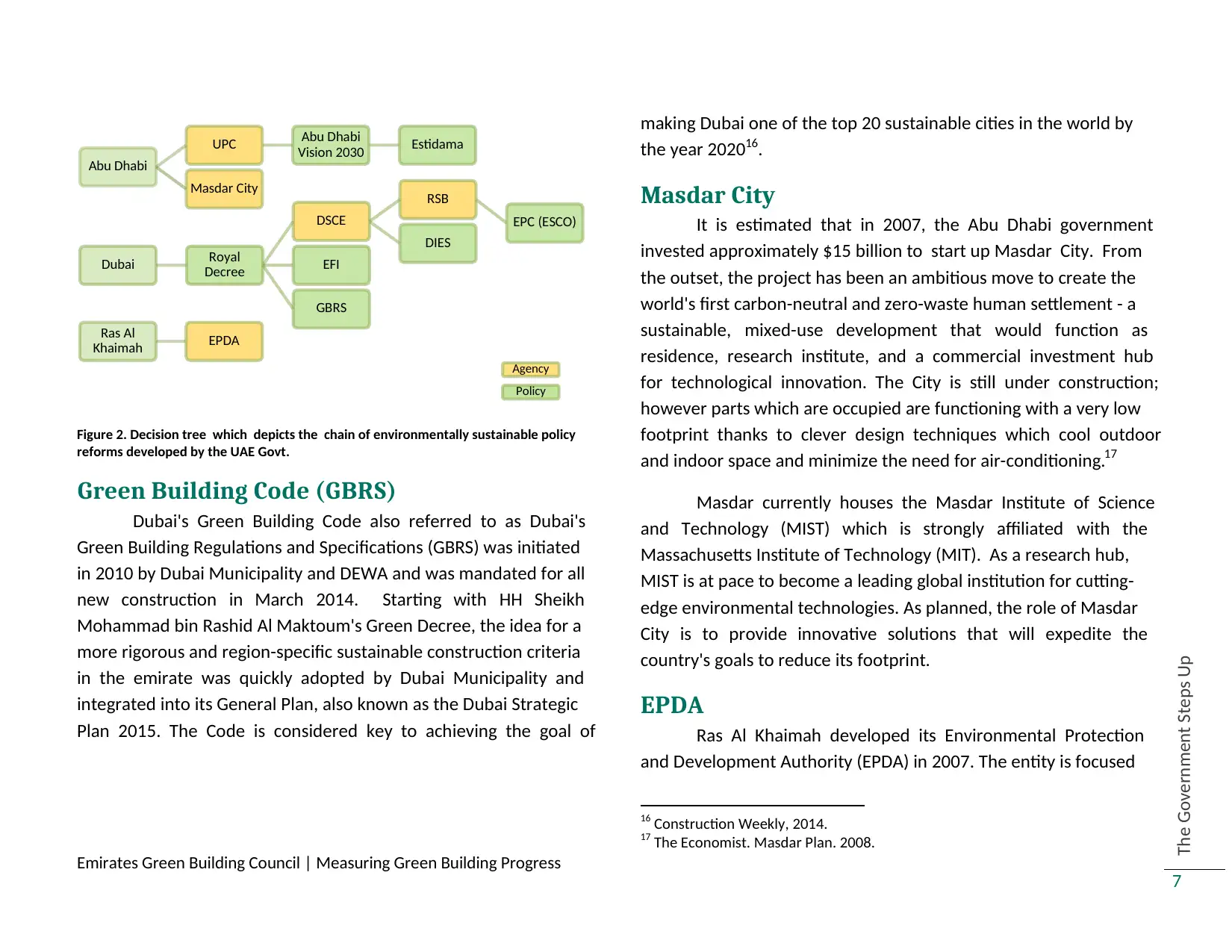
Emirates Green Building Council | Measuring Green Building Progress
The Government Steps Up
7
Figure 2. Decision tree which depicts the chain of environmentally sustainable policy
reforms developed by the UAE Govt.
Green Building Code (GBRS)
Dubai's Green Building Code also referred to as Dubai's
Green Building Regulations and Specifications (GBRS) was initiated
in 2010 by Dubai Municipality and DEWA and was mandated for all
new construction in March 2014. Starting with HH Sheikh
Mohammad bin Rashid Al Maktoum's Green Decree, the idea for a
more rigorous and region-specific sustainable construction criteria
in the emirate was quickly adopted by Dubai Municipality and
integrated into its General Plan, also known as the Dubai Strategic
Plan 2015. The Code is considered key to achieving the goal of
making Dubai one of the top 20 sustainable cities in the world by
the year 202016.
Masdar City
It is estimated that in 2007, the Abu Dhabi government
invested approximately $15 billion to start up Masdar City. From
the outset, the project has been an ambitious move to create the
world's first carbon-neutral and zero-waste human settlement - a
sustainable, mixed-use development that would function as
residence, research institute, and a commercial investment hub
for technological innovation. The City is still under construction;
however parts which are occupied are functioning with a very low
footprint thanks to clever design techniques which cool outdoor
and indoor space and minimize the need for air-conditioning.17
Masdar currently houses the Masdar Institute of Science
and Technology (MIST) which is strongly affiliated with the
Massachusetts Institute of Technology (MIT). As a research hub,
MIST is at pace to become a leading global institution for cutting-
edge environmental technologies. As planned, the role of Masdar
City is to provide innovative solutions that will expedite the
country's goals to reduce its footprint.
EPDA
Ras Al Khaimah developed its Environmental Protection
and Development Authority (EPDA) in 2007. The entity is focused
16 Construction Weekly, 2014.
17 The Economist. Masdar Plan. 2008.
Abu Dhabi
UPC Abu Dhabi
Vision 2030 Estidama
Masdar City
Dubai Royal
Decree
DSCE
RSB
EPC (ESCO)
DIES
EFI
GBRS
Ras Al
Khaimah EPDA
Policy
Agency
The Government Steps Up
7
Figure 2. Decision tree which depicts the chain of environmentally sustainable policy
reforms developed by the UAE Govt.
Green Building Code (GBRS)
Dubai's Green Building Code also referred to as Dubai's
Green Building Regulations and Specifications (GBRS) was initiated
in 2010 by Dubai Municipality and DEWA and was mandated for all
new construction in March 2014. Starting with HH Sheikh
Mohammad bin Rashid Al Maktoum's Green Decree, the idea for a
more rigorous and region-specific sustainable construction criteria
in the emirate was quickly adopted by Dubai Municipality and
integrated into its General Plan, also known as the Dubai Strategic
Plan 2015. The Code is considered key to achieving the goal of
making Dubai one of the top 20 sustainable cities in the world by
the year 202016.
Masdar City
It is estimated that in 2007, the Abu Dhabi government
invested approximately $15 billion to start up Masdar City. From
the outset, the project has been an ambitious move to create the
world's first carbon-neutral and zero-waste human settlement - a
sustainable, mixed-use development that would function as
residence, research institute, and a commercial investment hub
for technological innovation. The City is still under construction;
however parts which are occupied are functioning with a very low
footprint thanks to clever design techniques which cool outdoor
and indoor space and minimize the need for air-conditioning.17
Masdar currently houses the Masdar Institute of Science
and Technology (MIST) which is strongly affiliated with the
Massachusetts Institute of Technology (MIT). As a research hub,
MIST is at pace to become a leading global institution for cutting-
edge environmental technologies. As planned, the role of Masdar
City is to provide innovative solutions that will expedite the
country's goals to reduce its footprint.
EPDA
Ras Al Khaimah developed its Environmental Protection
and Development Authority (EPDA) in 2007. The entity is focused
16 Construction Weekly, 2014.
17 The Economist. Masdar Plan. 2008.
Abu Dhabi
UPC Abu Dhabi
Vision 2030 Estidama
Masdar City
Dubai Royal
Decree
DSCE
RSB
EPC (ESCO)
DIES
EFI
GBRS
Ras Al
Khaimah EPDA
Policy
Agency
⊘ This is a preview!⊘
Do you want full access?
Subscribe today to unlock all pages.

Trusted by 1+ million students worldwide
1 out of 33
Your All-in-One AI-Powered Toolkit for Academic Success.
+13062052269
info@desklib.com
Available 24*7 on WhatsApp / Email
![[object Object]](/_next/static/media/star-bottom.7253800d.svg)
Unlock your academic potential
Copyright © 2020–2025 A2Z Services. All Rights Reserved. Developed and managed by ZUCOL.

